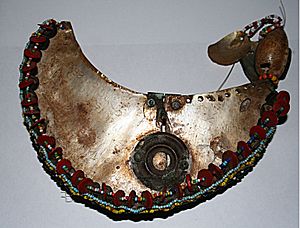Kula ring facts for kids
Kula is a very old and special way of trading that happens in a place called the Milne Bay Province in Papua New Guinea. It's not just about trading items; it's also about making friends and showing respect.
Contents
What is the Kula Ring?
The Kula trade happens across eighteen islands, including the famous Trobriand Islands. Thousands of people are involved in this unique system. Traders travel long distances by canoe, sometimes hundreds of miles.
They exchange two main types of valuable items:
- Red shell necklaces, which travel in one direction (usually north).
- White shell armbands, which travel in the opposite direction (usually south).
This creates a giant "ring" of moving valuables around the islands. The rules for trading can change from one island to another. For example, on some islands, a white armband might be traded for a necklace. Also, who can join the trade varies. In the Trobriand Islands, mostly chiefs take part. But in Dobu, anyone can join in.
Building Trade Relationships
The Kula valuables are mostly traded to gain social status and respect in the island community. When people trade with each other, they become trusted partners. This often creates strong friendships that can last a lifetime.
These relationships need a lot of trust from both sides. Traders also agree to keep each other safe and offer support.
How Kula Trade Works
Kula valuables are usually passed on to new trade partners after some time. This means the items are always moving around the Kula Ring. The person who first owned a valuable item has full rights over it. They can choose to keep it, sell it, or even break it.
Everyone else who receives the item does not fully own it. The original owner still has the true ownership. This makes traders feel responsible for how they handle the item. Sometimes, the original owner gets lost in the Kula Ring and is no longer known.
The Rules of Kula
Not just anyone can join the Kula Exchange right away. A person must first "buy" their way into the system. They do this by taking part in smaller trade circles before joining the main Kula.
Kula valuables are judged by how valuable they are and how old they are. The relationships made through trading are also valued this way. Traders often try to get famous Kula objects. This helps to make their own name more respected in the Kula Ring.
The Kula Exchange is built on trust, strong social duties, and a shared cultural value system. People who hold onto their Kula valuables for too long can get a bad reputation.
Social Status and Kula
The Kula Exchange system helps decide who has power and status among the trading islands. For example, in the 1970s, chiefs on the Trobriand Islands owned the most shells. They also had the most valuable shells. This meant they were in charge of most of the trade in their area. (Annette B. Weiner, 1988)
The ten most important men across all the islands control about 90 percent of the Kula items. With so much control and competition, relationships between traders can sometimes become difficult.
Images for kids
See also
 In Spanish: Intercambio kula para niños
In Spanish: Intercambio kula para niños




